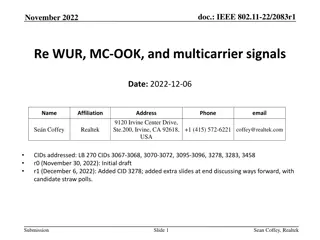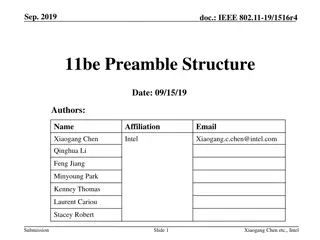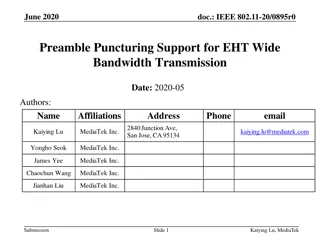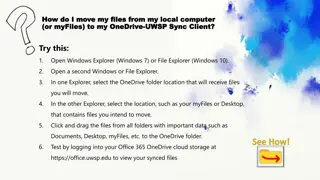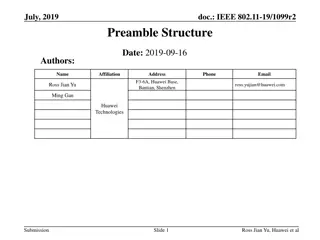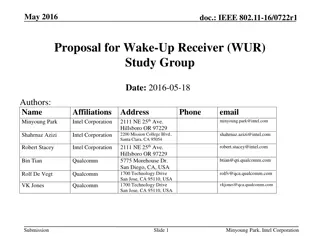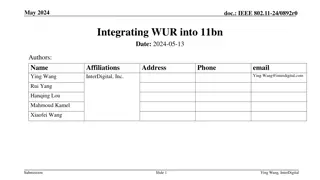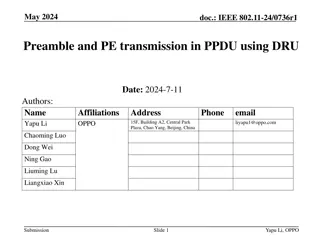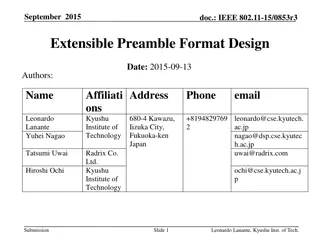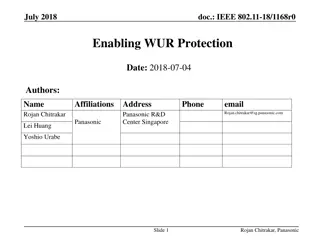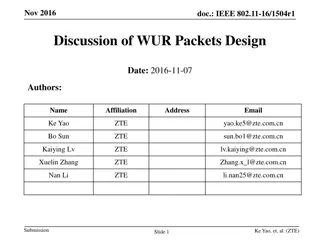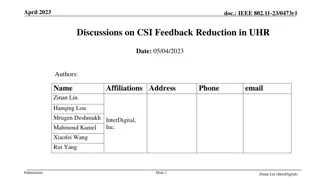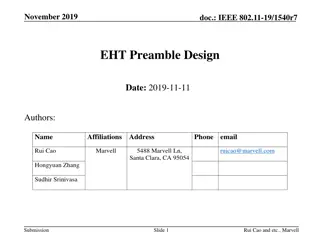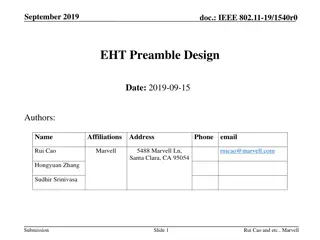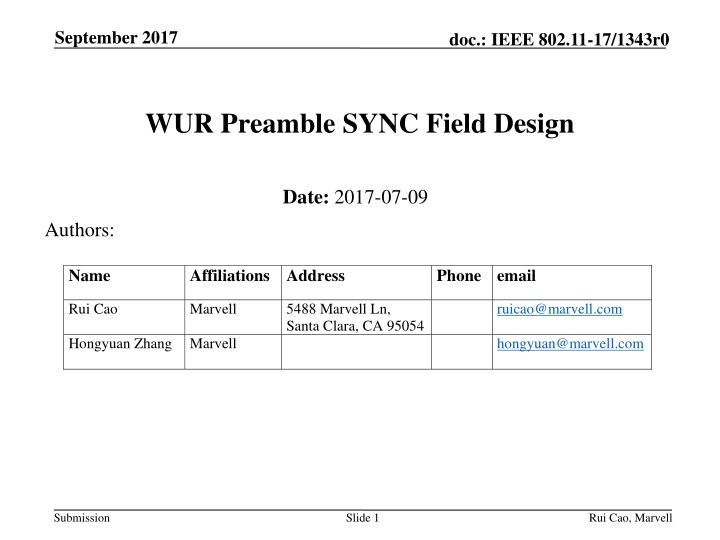
IEEE 802.11-17 Dual SYNC Sequences Design Analysis
Explore the design and evaluation of dual SYNC sequences for mode and rate signaling in IEEE 802.11-17. This analysis covers criteria, properties, and considerations for optimizing reliability and efficiency in SYNC sequence design.
Download Presentation

Please find below an Image/Link to download the presentation.
The content on the website is provided AS IS for your information and personal use only. It may not be sold, licensed, or shared on other websites without obtaining consent from the author. If you encounter any issues during the download, it is possible that the publisher has removed the file from their server.
You are allowed to download the files provided on this website for personal or commercial use, subject to the condition that they are used lawfully. All files are the property of their respective owners.
The content on the website is provided AS IS for your information and personal use only. It may not be sold, licensed, or shared on other websites without obtaining consent from the author.
E N D
Presentation Transcript
September 2017 doc.: IEEE 802.11-17/1343r0 WUR Preamble SYNC Field Design Date: 2017-07-09 Authors: Name Affiliations Address Phone email Rui Cao Marvell 5488 Marvell Ln, Santa Clara, CA 95054 ruicao@marvell.com Hongyuan Zhang Marvell hongyuan@marvell.com Submission Slide 1 Rui Cao, Marvell
September 2017 doc.: IEEE 802.11-17/1343r0 Introduction In previous contributions[1, 2], the design of dual SYNC sequences are proposed to facilitate mode or rate signaling We propose the design of dual SYNC sequences and evaluate the performance Submission Slide 2 Rui Cao, Marvell
September 2017 doc.: IEEE 802.11-17/1343r0 Recap: Dual WUR SYNC Design BPSK Symbol LSTF LLTF LSIG WUR Data WUR SYNC1 BPSK Symbol LSTF LLTF LSIG WUR Data WUR SYNC2 Two possible SYNC sequences: SYNC1 and SYNC2 Receiver tries to detect both SYNC sequences If SYNC1 is detected, one set of mode/rate is used for WUR Data If SYNC2 is detected, the other set of mode/rates is used for WUR Data One example: SYNC1 signals lower rate, SYNC2 signals higher rate To achieve better reliability for low-rate mode, prefer longer sequence To achieve better efficiency for high-rate mode, prefer shorter sequence Submission Slide 3 Rui Cao, Marvell
September 2017 doc.: IEEE 802.11-17/1343r0 SYNC Design Criteria SYNC1 and SYNC2 have good autocorrelation (AC) properties, including the 6 legacy 20MHz symbols AC(S) = ???? ?,flip(2 ? 1) , where ? = ? ? ? ? ? ? ? ,and ? is the SYNC low correlation for all offsets Find the SYNCs with smallest offset correlation ratio: SYNC1 and SYNC2 have low mutual cross correlation(CC), including the 6 legacy 20MHz symbols ? ?+5AC(S)[k] AC(S)[N+5] max CC(S1, S2) = ???? where ?1 = ? ? ? ? ? ? ?1 ,and ?1,S2 are the SYNC pair ?1,flip(2 ?2 1) , low cross correlation for all offsets Find the SYNCs with smallest cross correlation ratio: CC(S1, S2)[k] CC(S2, S1)[k] max ? max ? + AC(S2)[N+5] AC(S1)[N+5] Submission Slide 4 Rui Cao, Marvell
September 2017 doc.: IEEE 802.11-17/1343r0 Dual SYNC Design M-sequence is a good candidate, which satisfies the autocorrelation property [3, 4] M-sequence is of length 2^N-1, which is not of zero DC Add one 0/1 to make length of 2^N, with good autocorrelation property Similar to Gold sequence pair design, pick two M-sequences that meet the cross-correlation criteria With SYNC1 and SYNC2 length (N1, N2) design, find all M-sequence pair associated with different prime polynomials Add one 0/1 to make length of 2^N1 and 2^N2 Find the pair with the least cross-correlation ratio Submission Slide 5 Rui Cao, Marvell
September 2017 doc.: IEEE 802.11-17/1343r0 Candidate Dual SYNC Sequences S1 S2 SYNC1/SYNC2 AutoCorr Max Ratio CrossCorr Max Ratio length 16 length 16 1 0 0 1 1 0 1 0 1 0 1 1 1 0 0 0 0.1250 0.2500 1 1 0 1 0 1 1 0 0 1 0 0 0 1 0 1 0.1250 0.1875 1 0 1 1 0 0 0 0 1 1 1 0 0 1 1 0 1 0 1 1 1 1 0 1 0 0 0 1 0 0 1 0 0.1250 0.1250 32 16 1 1 1 0 0 0 1 0 0 1 1 0 1 0 1 0 0.1250 0.250 1 0 1 1 0 0 1 1 1 0 0 0 0 1 1 0 1 0 1 0 0 1 0 0 0 1 0 1 0 1 1 1 0.0938 0.1250 32 32 0 0 1 0 1 1 1 1 0 1 1 1 0 0 0 1 0 1 0 1 1 0 1 0 0 0 0 1 1 0 0 1 0.0938 0.1250 1 1 0 0 1 1 1 1 0 1 1 1 0 1 0 1 1 0 1 0 0 1 1 0 1 1 0 0 0 1 0 0 1 0 0 0 0 1 1 1 0 0 0 0 0 1 0 1 0 1 1 1 1 1 0 0 1 0 1 0 1 0 0 0 0.0938 0.1875 64 16 1 0 1 0 1 1 0 0 1 0 0 0 1 0 1 1 0.1250 0.1875 1 0 1 1 0 0 1 0 1 1 0 1 0 1 1 1 0 1 1 1 1 0 0 1 1 0 0 0 1 0 1 0 1 0 0 1 0 1 1 1 1 1 0 1 0 0 0 0 0 1 1 1 0 0 0 0 1 0 0 1 0 0 0 1 0.1250 0.0938 64 32 1 0 1 1 0 0 1 1 1 0 0 0 0 1 1 0 1 0 1 0 0 1 0 0 0 1 0 1 0 1 1 1 0.1250 0.1563 0 1 1 0 1 1 1 0 1 1 0 0 1 1 0 1 0 1 0 1 0 1 1 1 1 1 0 0 0 0 0 1 0 0 0 0 1 1 0 0 0 1 0 1 0 0 1 1 1 1 0 1 0 0 0 1 1 1 0 0 1 0 0 1 0.0938 0.0938 64 64 1 1 1 0 0 1 0 1 0 1 0 0 0 1 1 0 0 1 1 1 1 0 1 1 1 0 1 0 1 1 0 1 0 0 1 1 0 1 1 0 0 0 1 0 0 1 0 0 0 0 1 1 1 0 0 0 0 0 1 0 1 0 1 1 0.1406 0.1406 Submission Slide 6 Rui Cao, Marvell
September 2017 doc.: IEEE 802.11-17/1343r0 Simulation Settings Packet BPSK Symbol LSTF LLTF LSIG 2ms noise WUR SYNC WUR Data WUR signal uses center 4MHz in 20MHz bandwidth 2ms noise before the WUR packet Payload: 24 bits, Manchester Coding SNR defined on 20MHz noise CFO = 20ppm, fc = 2.4GHz, No phase noise Receiver 5th order 4MHz butterworth filter with 2.5MHz cutoff frequency Simple AGC based on 6 legacy 20MHz symbols 20MHz sampling rate with in-phase path Local cross-correlator template has 1 for bit 1, and -1 for bit 0 Submission Slide 7 Rui Cao, Marvell
September 2017 doc.: IEEE 802.11-17/1343r0 Channel: DNLOS WUR SYNC, DNLOS 0 10 250kpbs -1 10 PER 62.5kpbs -2 10 IdealTiming SYNC1: 32*4, SYNC2: 16*4 SYNC1: 32*4, SYNC2: 32*4 SYNC1: 64*2, SYNC2: 16*2 SYNC1: 64*2, SYNC2: 32*2 -3 10 -10 -8 -6 -4 -2 0 2 4 6 SNR (dB) Submission Slide 8 Rui Cao, Marvell
September 2017 doc.: IEEE 802.11-17/1343r0 Channel: DNLOS (32-4us, 16-4us) WUR SYNC, DNLOS, RxRate=20MHz 0 10 IdealTiming RealTiming Pmiss Pfalse PerrSync -1 10 PER -2 10 -3 10 -10 -8 -6 -4 -2 0 2 4 6 SNR (dB) Submission Slide 9 Rui Cao, Marvell
September 2017 doc.: IEEE 802.11-17/1343r0 Channel: DNLOS (64-2us, 32-2us) WUR SYNC, DNLOS, RxRate=20MHz 0 10 IdealTiming RealTiming Pmiss Pfalse PerrSync -1 10 PER -2 10 -3 10 -10 -8 -6 -4 -2 0 2 4 6 SNR (dB) Submission Slide 10 Rui Cao, Marvell
September 2017 doc.: IEEE 802.11-17/1343r0 Summary Dual SYNC sequence design is an appealing design The sequence pair can be designed from M-sequences with minimum auto-correlation and cross-correlation False SYNC sequence detection rate is low For dual SYNC design to signal one low rate and one high rate Longer SYNC1 sequence plus shorter SYNC2 sequence is preferred Submission Slide 11 Rui Cao, Marvell
September 2017 doc.: IEEE 802.11-17/1343r0 Reference [1] IEEE 802.11-17/0679r2, Preamble Design for WUR WLAN [2] IEEE 802.11-17/1345r0, PHY frame format discussions [3] IEEE 802.11-17/0997r0, preamble-options [4] IEEE 802.11-17/0991r0, preamble-design-and- simulations Submission Slide 12 Rui Cao, Marvell

